#factorio modding
Explore tagged Tumblr posts
Text
I'd like to make an announcement.
Noise expressions are pain. Holy shit.
ClaustOrephobic, my mod, is built ENTIRELY using the data stage, and so it uses them heavily.
You might ask why the mod needs more work. It was working fine and there hasn't been a major version update since then to break it, especially not one that touched autoplaces. You would be correct. This basically all started from some minor bug fixes. Allowing enemies to expand again, allowing trees to spawn more than once in a blue moon, so on and so forth.
Cliff spawning, however... is not nearly so easy to fix. Factorio has hardcoded behavior for cliff generation, and the generation takes place after everything else generates. This generation uses a hard-coded collision mask, not the collision mask of the cliffs, so ClaustOrephobic's ore generation will always block the cliffs as long as it is present in the same place Factorio tries to generate cliffs.
It's not impossible to fix from my end though. I just have to get out of the way.
Problem is... to do that, I basically have to reconstruct the cliff generation from scratch or generate an additional surface for each surface my mod acts upon and copy the cliffs over. ClaustOrephobic doesn't use control-stage programming and I am NOT going to start now. The whole point of this mod is to be a purely data-stage implementation of DangOreous, with my own spin. Generating duplicate surfaces and copying the cliffs over would compromise this point.
So reconstructing the cliff generation from scratch it is!
I hate myself. Why do I have to be so damn stubborn and obsessive about this shit.
Anyway. That means I need to create four copies of every used elevation function and do so algorithmically so that it can adapt to any other mod's nonsense, because that's another point of ClaustOrephobic: the best fucking mod compatibility I can make. These four copies need to be placed at the corners of possible cliff locations, so I can know when the necessary elevation thresholds are crossed on the edges (because according to old Friday Facts and the documentation, the edges are where the elevation matters) so that I can then remove all ore from that area if a cliff generates there... before the cliffs generate.
Oh did I mention I have to automatically repeat this process for every single cliff type (vanilla has 1) and create an associated setting for each copy. And then I have to override these settings during startup so the world generates properly using control-stage programming.
Yes, I'm going to have to cheat my rule slightly. But technically the rule is 'no runtime', so running stuff at save start is fine by me.
Man, my life would be so much easier if I could just alter collision masks for cliffs or have Factorio automatically remove ores obstructing cliffs. But nooooooo.
Instead I have to do this nonsense.
0 notes
Text
feel like I'm having a sort of delayed reaction to Satisfactory and Factorio doing really well with their updates since my perspective has mostly been that well duh they're gonna do well they're really good games
but now it's hitting me that they're becoming prominent enough to possibly have some cultural effect on the games industry
will be interesting to see if we see more automationy stuff seep into other genres, it's already happening a tiny bit
heck it'd be funny if we live to see a mainstream AAA automation game - probably not that likely, but I'm sure we can expect to see it in one as a side system, assuming we haven't already
it feels like a little automation is a straightforward addition to the basic base building you'll see bolted onto random games sometimes (and extremely basic automation is already a common element in these systems anyway)
#and of course I am also very excited for the indie automation games that have already been spawned and will be spawned#by factorio and modded minecraft and now satisfactory#an example of this trend already in action is arknights endfield having a whole factory building element in addition to the action combat#and it's a gacha game
9 notes
·
View notes
Text
theres a surprising lack of magic mods for factorio somehow
when are they gonna make thaumcraft for factorio
8 notes
·
View notes
Text
very excited for future factorio players to complain about how the inserter that places things in stacks is not in fact the stack inserter
33 notes
·
View notes
Text
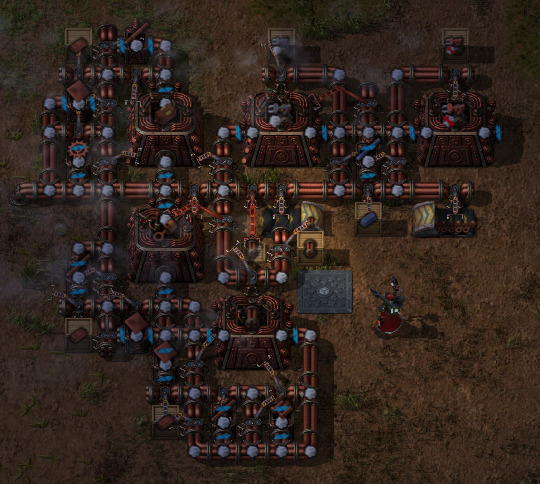
Guys I have no fucking clue what I'm doing.
#factorio#industrial revolution 3#modded factorio#my screenshots#I dunno if I should use the “pls help” tag that one seems serious
9 notes
·
View notes
Text
Factorio Space Exploration: Arcosphere Cookbook with explanations

I found the arcosphere puzzle intriguing but poorly explained and clunky, and when looking for advice I found a lot of other frustrated people who were brute-forcing the puzzle, using giant combinator fields, and/or copying entire solution blocks from other people's blueprints. I have further complaints, like the strict spoiler policy and the F:SE wiki deliberately avoiding this info, so I'm going to talk about arcospheres and try to make this be something like the reference I wanted. I will try to explain principles, not just solve, to help people understand. This will be long, and have colored diagrams.
Contributing to my frustration is that Arcospheres are a finite*, accidentally losable resource that are required for victory. On the Cruelty Scale from interactive fiction, Arcospheres put Space Exploration somewhere around Nasty. Having a spoiler policy on top of this is rude!
So. When you first get spaceballs, they are bland grey. You can get some from looting ancient ruins and the Interburbul game on other planets, but the main source is from the deep void, by launching arcosphere collectors from deep space asteroid fields. These have diminishing returns, so start with about 5 from each field. Make sure to launch the collector, not the arcosphere, I've seen one guy lose his spheres that way because he was outputting silo spheres into the same container that collectors were loading from, and the loader loaded arcospheres instead.
Then you put them through Arcosphere Polarization. This takes in 4 grey balls and puts out a set of 4 colored arcospheres: either [Lambda, Zeta, Epsilon, Gamma] or [Xi, Theta, Phi, Omega]. Do some of both recipes to get all 8 types. A machine set to run continuously will randomly flip between them - this comes up later - but you can manually set it for your first few spaceballs.
Arcospheres are unusual in that they're not consumed like most ingredients in Factorio, instead they are merely transformed between the different polarities. The recipe for a Naquium Tesseract takes in 3 arcospheres [Lambda, Xi, Zeta] and outputs 3 arcospheres [Theta, Epsilon, Phi].
Productivity modules are banned here, naturally.
*Finite: Arcospheres are hard to produce, with arcosphere collection from space having logarithmically diminishing returns, which means at some point it would take a lifetime of play to get another set. Make sure to keep them well protected from biters, meteor strikes, spaceship landings, and so on.
Since the full names are heck to diagram and the greek letters are heck to type, I'm going to refer to the 8 polarizations by their English-language initials: L, X, Z, T, E, P, G, O. That's the order the items are sorted ingame, don't blame me.

Next it's useful to visualize the various arcosphere folds and transforms. Since there's 8 of them, we can map them to the corners of a cube, and a cube is relatively simple to diagram as two squares. I will label the corners in semi-clockwise order, which makes several of the folds easier to visualize the patterns for, and color them correspondingly. Starting with the Arcosphere Polarization, you can see it produces either inner (LZEG) or outer (XTPO) spheres.
Next is the Arcosphere Inversion basic recipes, it would be a nuisance to memorize exactly which four invert, but with the diagram...

...it's swapping the diagonals. Inversion is invertible.
Then there's 8 kinds of basic Arcosphere Folding. The first one is [LO] -> [XT] and we can think of this as X-centric. Each fold is centered on a corner: it takes in the "previous" (counterclockwise) and the parallell sphere, outputs the chosen corner and the "next" (clockwise) sphere. Each fold takes one inner and one outer sphere, outputs either two inner or two outer. Here's the X-centered and the L-centered fold.

Here's all eight of them in a block. Stare at it, feel the patterns.

With this, I find it much easier to think about recipes in terms of "I have..." and "I need..." when I know they move sorta-clockwise, and are output in adjacent pairs.
Also, each column as presented forms a combination to build from. If you have [OL,XG] you can run the two leftmost recipes and output [XT,LZ]. Reorder these and it's [LXGO] -> [LXZT]. We have used LX as a catalyst to turn GO into ZT.
This generalizes by rotation. If you have one of the half-diagonals such as [LX], [ZT], [EP] or [GO], you can convert it into the opposite half-diagonal this way. This is the 1st combination recipe.
Here's what this looks like in practice in Factorio, with the pair from the fourth column that combines [GP]->[OX] and [EO]->[GL], with a net result of [EP] -> [LX].

[EP] comes in at left, is taken up by the first set of filter inserters. [GO] is a catalyst, passed between the two gravimetrics machines indefinitely. [LX] is output to the right.
In addition to turning a half-diagonal-pair into its opposite with 2 catalyst spheres, any two of a single polarity can be turned into their opposite with 1 catalyst. (Opposite corner cubewise, so L becomes P, not E.) This is the 2nd combination recipe.
You may want to copy the Eight Folds diagram to use as a reference for the individual steps here. Starting with for example two Lambda, we use an Omega as a catalyst, and perform the following folds, converting the pair marked in brackets at each step.
L [L O] [L T] X E [Z X] [E T] P O P P
And here's that built in Factorio:

Place an [O]mega catalyst in the upper left machine once the very first time, then insert many L in top chest. They will be converted to P, and the O catalyst returned to upper left after each pass.
The topmost filter inserters from the L chest are wired to take only when (Lambda > 1) to ensure even splits in my demo, you could use a splitter belt or something else for the same effect. The middle red long inserter uses a nonobvious Factorio feature: when pointing into a machine, inserters will only take ingredients needed in that machine's recipe, so it will only take the E and not the Z from the top-right machine to the lower-left machine.
The full set of 8 opposite-corner chains:

Now we've got the Inversion recipe that switches full diagonals of 4, turning a diagonally adjacent pair into the other half of the diagonal, and turning a single ball into its opposite corner, and. That leaves one more building block of useful folding combinations:
Turning an opposite-corner pair into the other two on its long diagonal. This phrase sounds clunky even to me, so here's the visual: starting with a bunch of L, generate LP, and from there XLEP.

The [LP] -> [XE] transform is accomplished with only one catalyst ball, but needs more balls to be converted. You need to start with LLPP, and use T as catalyst into XXEE, with subelements of [LP]->EE and [LP]->[XX]. This is the 3rd combination recipe.
The specific steps: [TL] P E [ZP] EE G and then use that G as intermediate catalyst for [GP] L X [OL] XX T giving you the T back.
This takes a little bit of sorting input to build the machines. Factorio build with similar 4-machine shape to the above, note again the wired inserters set to (L>1) and (P>1), can be replaced with belt splitters or other method of even distribution. The whole system can be rotated and rearranged. Think of this as a Lego-like toolkit, not a definitive solution. (That's why I'm posting diagrams, not blueprints.)

Place a single catalyst T in the top-left [LT] machine to start, and the system will turn sets of [LLPP] into [XXEE], returning the T.
The four sets of this are: T as catalyst to turn [LLPP] into [XXEE] O as catalyst to turn [XXEE] into [LLPP] P as catalyst to turn [ZZOO] into [GGTT] X as catalyst to turn [GGTT] into [ZZOO].
Let's revisit the diagram.
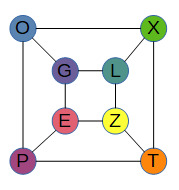
Starting from a bucket of one single arcosphere such as L, you now have the steps and components to:
Turn it into the opposite corner. (-> LP)
Turn those opposites into the rest of the diagonal. (-> XLEP)
Invert the diagonal. (-> OGZT)
Turn two diagonally adjacent balls into the opposite diagonal. (OG < - > ZT.)
and the rotations of these.
Combining these steps now gets you from any ball to any other ball, in sufficient quantities. For example, if you're running the Naquium Processor recipe that outputs five Lambdas, and you want to turn your stack of L into E:
L -> LP with opposite-corner LP -> XE with on-diagonal X -> E with opposite-corner.
With the building-block theory done for converting arcospheres, let's look at productive recipes featuring spaceballs. I'll start with the first data card from Deep Space Science 3: Space Folding Data.
The recipe for this card comes in two flavors: each takes Naquium Plate, Significant Data, -273C Thermofluid, and arcospheres [LX]. One flavor outputs ZT, and the other flavor outputs EP as our arcospheres. You can manually choose which the first time, but Factorio is all about the automation, and a machine set to automake Space Folding data may randomly swap between recipes each time a crafting has completed! So you need to plan for getting a mix of ZTEP out, unpredictably. Let's consult the diagram again. White for input, but grey and black for the two sets of output.

Well the EP is easy: just convert it back to LX, using a set of OG as catalysts.
The ZT output is a little harder. Convert half of it to OG (using a set of EP as catalysts) giving you the OGZT diagonal, then invert that into XLEP. Then filter the XL back into the data card maker, and and the EP can convert to XL.
How this might look in practice, zoomed out and labeled:

Zoomed in and cropped so it's easier to see filter settings:

Tracing the path through this system, start with the machine on the right. Insert some LX. If it comes out as EP, it takes the upper belt leftwards, and gets converted back into LX, easy peasy.
If it comes out as ZT, the two lower filters put that onto belts, and split them so that some ZT goes to become OG at the bottom, while the other ZT goes to join the fresh OG in the OGZT inversion machine on the left.
Space Warping Data is very similar and straightforward. You input [EP], get out OG and/or ZT, you convert as necessary until you have an OGZT set to turn into XLEP, and turn the extra XL into EP.
Space Dilation Data is a little harder. You input [ZO], and get out either LL or PP. Conditional wires on your inserters start to be useful here, as does having more arcospheres for a buffer when the random number generator is streaky. Hope for LLPP; but plan to convert LLLL or PPPP into LLPP. Turn some of the LP into XE, then a whole XLEP diagonal inverts to OGZT, and GT can be converted into OZ.
Space Injection Data gets tricky. You input [GT] and get out either ZZ or EE. For the first time, these aren't on the same diagonal. Oh well.
When you get Z, convert half of it to O with opposite-corner, then ZO to GT.
When you get E, convert half of it to X with opposite-corner, then convert half of the resulting EX mix to LP, giving you a full diagonal. Invert the XLEP diagonal to OGZT, and then convert OZ to GT. This requires five sets of folding combination machines, and it sprawls quite a bit and wants a large buffer of extra spheres.
I will note one more data card later in tech tree: Wormhole Data, [LZEG] -> [XTPO]. No randomization here.
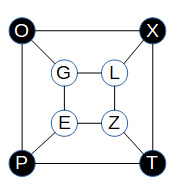
This is a sneaky recipe, because the diagonal steps described above can be used but it gets much larger than necessary because they're a poor fit.
Notice instead how this takes inners and produces outers. What turns outers back into inners? The basic Arcosphere Foldings.
Produce a set of XTPO, and keep a spare set of LZEG as a catalyst. Run the lower four basic foldings from the Arcosphere Folding block once each, like [XG]->[LZ], producing [LZ]+[ZE]+[EG]+[GL], or two sets of LZEG.
For the other recipes, like Naquium Tesseract, hopefully these visualizations and combinations have helped you understand what's going on and how to build your own design from parts. Or you can download someone else's solved blueprint. You don't need to bash your head against a wall of obfuscated math to play with spaceships.
You are welcome to copy, annotate, share and edit this guide as you like.
8 notes
·
View notes
Text
Ahem, I totally got these 1500 yellow science bottles to unlock Cerys Cargo Drops completely legitimately and I absolutely totally waited for literal hours to get the right amount of quality ingredients and deep enough into the mod to get this legitimately.
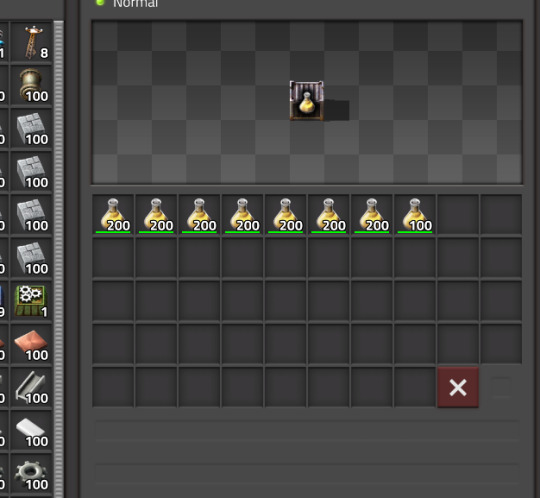
#factorio#factorio space age#if i have one complaint about the cerys mod its the mandatory quality#and the fact that you cant drop things onto cerys#i like the idea. but not with mandatory quality because quality without top tier modules is a pain
3 notes
·
View notes
Text
Playing a lot of factorio has given me completely unrealistic expectations for how well optimised early access factory games should be. Gear brain means that I'm always expanding my factory at every opportunity, and unsurprisingly most games actually do have a ceiling on factory size that you can hit in a few hours if you play like that
#I think the only factory that ever had problems in factorio was a heavily modded 200+ hour playthrough#one of these days I'll learn to stop buying early access games#my laptop just ain't good enough to run games that haven't been optimised yet#The problem is that early access is fun lmao
4 notes
·
View notes
Text
Factorio expansion planned for one year for now. It's Space Exploration but different, featuring Earendel explaining the difference
14 notes
·
View notes
Text
I made a mod for Factorio!
Factorio already has a heat system in the form of nuclear power, but wouldn't it be cool if you could use that heat to smelt items?
Introducing: Heat Powered Furnaces!
This is a specialized furnace that uses heat energy instead of electric power or burnable fuel! Bigger, with a higher crafting speed and lower energy consumption, but with the tradeoff of a more complex logistical challenge to use, I think it makes for some very interesting designs!
And just recently I've made new graphics, to move away from the 30 second MS paint drawing I was using before as a placeholder:

Let me know if you have any thoughts or questions about the balance or style of the mod!
6 notes
·
View notes
Text
Part 1 of Seablock run tech me and my friend use in our run: petrochem parallelization
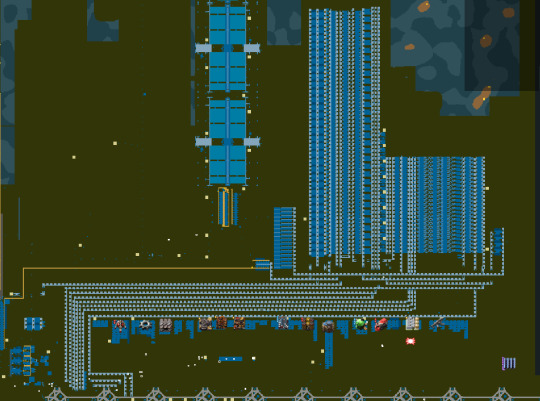
here is the overall map view of the set up

crude oil production and processing as well as synth gas processing
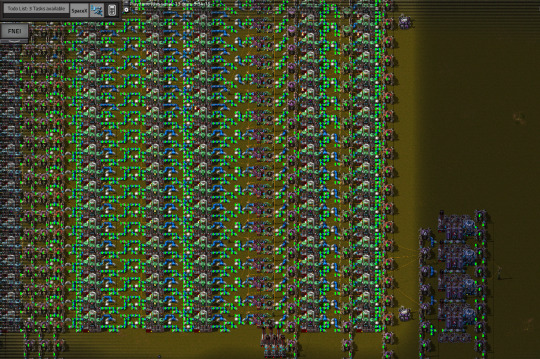
crude oil handeling and oil byproduct cracking and res gas handeling

how we transport the massive amounts of fluid we make
#factorio#seablock#factorio modded#petrochem prossesing#oh my god we have put so much time into this world and these designs#just wait for some of these other designs#automation
3 notes
·
View notes
Text
My boyfriend's best friend, Josh: "hey, saw you guys online, can I join?"
My BF: "Bob's."
Josh: "Nevermind bye"
11 notes
·
View notes
Text

finally connected a new sulfur mine to fix rubber production so i can make the amount of cables and gaskets i need for turbines so i can make nuclear power so i don't have to rely on oil for energy so i can redirect more oil to sulfur to fix rubber production
#factorio#bad mods in testing#idk rubber visibility on belts is kinda shit and if they aren't next to each other it looks like solid fuel#should i make rubber eraser-pink or something
7 notes
·
View notes
Text
i think i beat the game

#for those that dont play factorio#the bug alien things are enemies that are trying to kill me#(reason: i am genociding them)#and they attack in waves once my pollution cloud reaches their colonies#i can destroy their colonies#but that makes them evolve faster#however#the bugs cant cross water#and i got a mod that allows me to create and place water#i am now completely unstoppable
4 notes
·
View notes
Text
me, with a steam library of over 100 games: i have nothing to play :(
#nothing is hitting!!!#i really want to play kotor but it doesn't run very well#maybe sdv? but i would have to update my innumerable mods#*heavy sigh* i guess i'll play factorio and be overwhelmed w guilt at destroying a beautiful landscape in favor of industry#*dykeposting
4 notes
·
View notes
Text
I need rares, not epics! Come on!

#factorio#factorio space age#if i got one complaint about the cerys mod its that quality is required to progress#its already pretty grindy to get going and quality doesnt help#especially when you dont know its coming up
2 notes
·
View notes